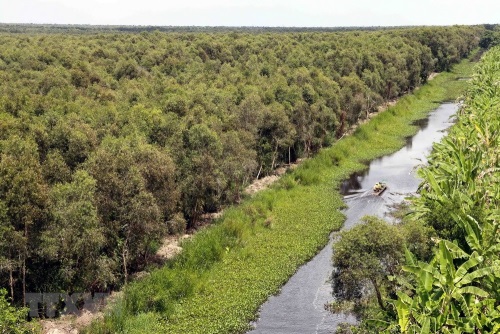A mangrove forest is a type of forest with trees growing in the big estuaries where the salt water mixes with the fresh water. When the tide comes in, a part of the mangrove forest or the whole forest will be submerged; when the tide goes out, the forest will appear in its entirety. This zone is of great value to socio-economic development, defence and security, ecosystem and biodiversity.
According to scientists, Vietnam has a large number and various types of mangrove forests located from the North to the South in 4 regions and 12 sub-regions. The National Park of U Minh is the largest mangrove forest in Vietnam with the total area of 8,053 hectares. Vegetation in the mangrove forest mainly includes trees with massive root system, such as mangrove, black mangrove, bruguiera, tea tree as well as shrubs and grasses of all types which form a “wall” for preventing waves and preserving land, thus accelerating the accretion of sediment. Mangrove forests are also inhabited by birds and fish as the forests act as the shelter to protect fish from dangers in the ocean. At the same time, a mangrove forest serves as a filter to absorb poisons in the water, harmonize the climate in the region, and protect human life.
 |
| U Minh Ha forest in Ca Mau province (photo: VNA) |
Due to their position and role, since the country was reunified, our Party and State have formulated guidelines and policies on protecting and developing the mangrove forests. As a result, many mangrove forests have been restored and expanded; the mangrove forests of U Minh and Can Gio have become tourist attractions which help restore the lands heavily devastated by war chemical poisons. However, the mangrove forests in some regions and localities have yet to be protected and preserved carefully and strictly; some have been even seriously destroyed. The reason is that the exploitation of the mangrove forests has not been associated with the preservation while the mangrove forests have been mainly transformed into aquaculture and agriculture, which could bring about both short-term economic benefits and unpredictable consequences. The disappearance of mangrove forests will accelerate the infiltration of sea water into the land, soil erosion, salinization, land and water pollution, even drastically reduce the rainfall and make the air hotter due to the increase in carbon dioxide, thereby severely impacting on the locals’ life and the sustainable development.
Against that backdrop, the Party, State, and Government have taken measures to preserve and restore the mangrove forests across the country. Sectors and localities have initially made plans for economic development in the mangrove forests, combined economic development with forest protection, studied and developed aquaculture in other seas to save the size of the mangrove forests, and implemented many projects for afforestation which concentrates on key areas first and expands the size of the forests later. Nevertheless, authorities at all levels should continue to well conduct the work of propagation and education to render cadres, party members and the people fully aware of the role of mangrove ecosystem in the process of economic development and nature preservation to minimize the impacts made by the climate change which could lead to the sea level rise. This is an important basis for preserving and exploiting the mangrove forests sustainably to develop the country.
Nguyen Van Su